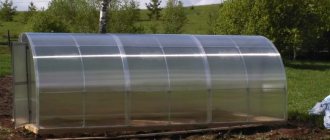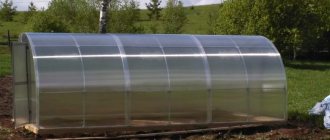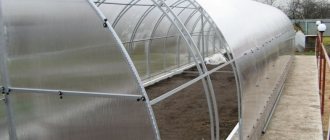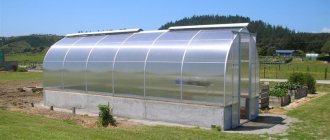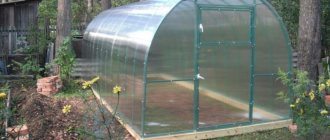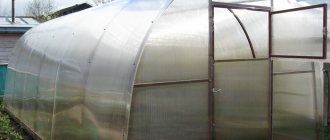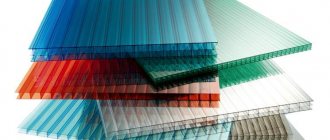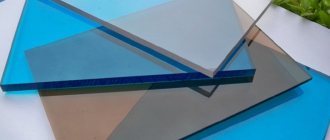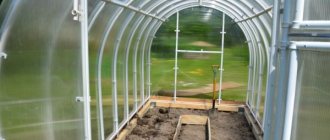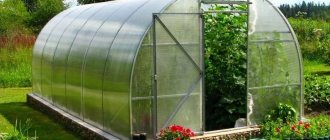Set of socks, Omsa socks
349 ₽ More details
Set of socks, Omsa socks
349 ₽ More details
Baths of Monaco
Since many people have garden plots and summer cottages, entrepreneurs have launched the production of prefabricated greenhouses. One of the most popular models was the “Maria Deluxe” model, in the creation of which the engineers used a special approach. From the article you will learn how to assemble the Maria Deluxe polycarbonate greenhouse.
Characteristics and Features
The kit is a strong frame that can withstand the most adverse weather conditions. The structure is made of lightweight materials, making it easy to assemble on site according to the instructions. The finished greenhouse has:
- base made of light wood, reducing the overall load on the ground;
Thanks to its wooden base, Maria Deluxe has minimal load on the ground
- sloping roof - one side is curved into an arch to prevent precipitation from accumulating, the opposite side rises above the base at an angle of 90°, which is convenient for planting plants directly next to the wall;
- two doors and windows on both sides for convenient watering and ventilation.
The structure is sheathed with lightweight polycarbonate. The individual parts are connected by wear-resistant plates equipped with bolts.
Assembly technology for the “Maria” greenhouse
The frame of these greenhouses is completely dismountable, consists of arched and straight elements and is assembled with strong bolts. When disassembled, “Maria” easily fits into the trunk of a regular passenger car - it is not difficult to transport and move from place to place.
And this is one of the most valuable advantages of this greenhouse - it is very easy to assemble and disassemble: if you call specialists, then four to five hours will be enough. But you can do everything with your own hands - in a day, if you take with you the following tools: a mallet, a 10 and 8 wrench, a knife with a retractable blade and a screwdriver.
Advantages and disadvantages
Two types of greenhouses of this model are produced: “Maria” and “Maria Deluxe”. The second option is preferable because:
- the frame is made of durable steel profile with a rectangular section of 20x30 mm to enhance strength and a thickness of 1.5 mm;
- All parts are galvanized - the structure is rust-resistant.
Dimensions of both greenhouses: 2x3x4 m. Although the structure can be extended, for which special inserts are used. The distance between the profile arcs of “Maria Deluxe” has been increased to a whole meter. Usable area – 4 sq. m.
The frame of the Maria Deluxe greenhouse is made of metal, which in turn increases the strength of the structure
Let's name the main advantages of the greenhouse:
- Any ventilation and watering option is suitable.
- If necessary, you can replace individual parts without completely dismantling the structure.
- The wall and foundation fastening system is designed for strong gusts of wind (up to 40 m/s), temperature fluctuations and high humidity (snow load up to 3 kg/sq. m).
- Easy to install, easy to operate.
In other models of polycarbonate greenhouses, the buyer has to choose: durable options are expensive, cheap ones do not have the desired strength.
This design offers “two in one”, while the manufacturer guarantees at least 7–8 years of normal operation if all operating precautions are followed.
The manufacturer of Maria Deluxe guarantees 8 years of normal operation with proper use
And yet, although profile pipes have sufficient strength, it is always recommended to clear snow from the roof. If the greenhouse is not used in winter, it is better to remove the polycarbonate covering.
Subtleties of self-assembly
The reinforced greenhouse Maria Deluxe is supplied with detailed assembly instructions. You can see the process with your own eyes in the video. Start your work with planning and drawing up a drawing. Choose a place in the garden for the greenhouse: a flat, well-lit area of suitable size. It should allow neighboring crops not to be in the shade all the time.
Experts still advise placing the greenhouse on a foundation. It will increase its durability. The easiest way is to build a support from a board or timber. A wooden foundation is not the most durable, but with proper care it can last a long time. In addition, it is easy to disassemble and reassemble in case of moving the greenhouse to another location.
Advice. When laying the foundation, control its position using a building level. Fasten the beams together with self-tapping screws, and in the corners - additionally with special metal corners.
Start assembling the frame from the bottom tier:
- Make markings on the metal base at the installation points of the arcs. Use a marker and tape measure.
- Attach the component clamps to the marked locations.
- Secure the base to the foundation using self-tapping screws. To start, just make some money.
- Assemble the base of the greenhouse ends. Secure the arcs and longitudinal parts tightly with T-shaped fasteners. The arc at the junction should not rest against the beam!
- Mount the end elements: first, 3-sided clamps on the base, and then the end planes into the clamps.
- Mount the arcs of the main frame into the brackets installed according to the markings. Tighten the bolts securely. Now the arcs should rest against the longitudinal beams.
- Proceed to installing the upper longitudinal beams using X-shaped brackets. The side arches should also rest against them.
- Tighten the remaining fasteners. Make sure that the frame is not deformed and does not lose its inherent rigidity.
Advice from experienced gardeners who independently installed the Maria greenhouse
- In addition to the main covering, it is necessary to purchase an additional piece of polycarbonate, which will be useful in cases where there may be a shortage of material due to improper cutting, and there will not be enough material for the end. Then this problem can be easily solved.
- To avoid accidentally damaging the polycarbonate during installation, you need to purchase drills with a good supply in advance. And organize the process in such a way that you immediately drill a hole in the profile, and then apply polycarbonate. Otherwise, the drill may accidentally move and break and ruin the polycarbonate.
- To insulate the bottom of the greenhouse, you need to place the greenhouse on a beam made of pine or larch measuring 50x70, treated with an antiseptic. The beam must be placed on the outside of the greenhouse, since the edge of the polycarbonate will hang slightly below the metal base. It is much more convenient to attach the bottom of the greenhouse to wood than to metal.
- In harsh climates, it is advisable to attach additional struts to the greenhouse, which will strengthen it on all sides and prevent possible destruction in a strong storm.
If you use all the tricks and take precautions, which experienced gardeners advise, the Maria greenhouse will survive all climatic disasters and neighboring greenhouses from other manufacturers that cannot withstand the load, and will serve you for decades. And most importantly, it will delight you and your family with high yields of all kinds of vegetables and herbs, providing a complex of vitamins essential for the body!
Advantages of these models over others
The “Mary” design itself is very convenient - on the one hand, it is arched, and snow rolls off easily, on the other hand, its sides are straight at least up to half the height, and therefore plants can be planted right next to the walls, without indentation, which saves a lot of space.
A distinctive feature of this greenhouse is the fastening of its elements - special plates with bolts. And this makes sense: of course, monolithic products are always stronger than prefabricated ones - if you do not take into account the pressure of some external factors. But when there is a strong snowstorm in winter, or a record amount of snow falls, sometimes the most expensive monolithic structures cannot withstand this - they bend, become seriously deformed and even break. And the whole point is in their static nature - it is the lack of flexibility and freedom of movement that makes them vulnerable. The dynamics are thought out here - invisible to the eye, but extremely important.
It's simple physics. For example, monolithic workers do something similar when they pour a strip foundation - they never weld transverse reinforcement bars together - they only tie them together with wire. Because even a house with its zero level also moves under the influence of soil movement, compressing and decompressing in an invisible way, and tightly welding the reinforcement is a guaranteed rupture and crack along the entire wall. The same principle applies here - it would seem that the not most convenient way of assembling the frame guarantees it at the same time protection from frame breakage in severe bad weather, for which the northern regions of Russia are especially famous.
Many more summer residents are attracted to the Maria greenhouse by the convenience of its ventilation and watering - and all thanks to the doors and windows at both ends. Plus, all elements of the frame in the factory are necessarily covered with a special polymer frost-resistant coating, which significantly reduces the possibility of corrosion on the metal and allows the greenhouse to be used in winter - it is not afraid of either frost or strong wind.
Installation instructions
The store-bought kit includes:
- Bolts and fastening parts.
- Metal frame - arched and straight profile pipes.
- Polycarbonate roll - standard panel size 6 by 2.1 meters.
Large vehicles are required for transportation. For example, a minibus. The finished greenhouse, if necessary, can also be easily disassembled and then moved to a new site.
To assemble the structure you will need:
- set of wrenches;
- set of drills;
- knife;
- pliers;
- roulette;
- screwdriver
Foundation
First of all, a completely flat area is required for installation. Do-it-yourself assembly technology does not require a foundation. It is enough to use special supports that are driven directly into the soil. But if moving the greenhouse is not planned and it is installed for a long time, experts advise making a reliable foundation. It can be concrete, wood or brick.
If you decide to mount directly on the ground, experts recommend strengthening the supports with wooden blocks. This will make the support more stable. Impregnation with an antiseptic will protect the wood from rotting and drying out.
A few words about polycarbonate - rules and tips
The frame is completely assembled, it’s time to cover it with cellular polycarbonate.
On the pages of our resource we have already described how to cover greenhouses with this material. Therefore, we will not repeat ourselves; our regular readers are already familiar with this issue.
Today we just want to give some recommendations for working with this material, which may be very useful to you.
Sometimes industrial greenhouses are positioned in that cellular polycarbonate is fastened to them using special clamps and other devices.
But by and large, this is a kind of advertising ploy by manufacturers. In any case, no matter what type of greenhouse is used with cellular polycarbonate, in each case, one way or another, fastening with self-tapping screws is used.
Therefore, compliance with the rules for fastening cellular polycarbonate is the key to the successful functioning of the entire structure.
Protective polycarbonate coating
When working with this coating, it is important to know that the polycarbonate surface has special protection designed to block most of the ultraviolet radiation. Damage to this coating entails the most negative consequences for plants.
Anyone who has encountered cellular polycarbonate knows that this material is supplied in sheets coated with a protective film.
Many people, before starting to cut the sheet for the greenhouse, remove the protective film. This is a gross violation.
Sheets must be cut together with a protective film. It should be removed only when the sheet is cut and installed in its place.
Basic mistakes
Sometimes you can see that when fastening polycarbonate, self-tapping screws with wide heads are used, and the fastening is done through the sheet by directly drilling the sheet with the screw itself.
This is fundamentally wrong.
- Before installing the fastener, it is necessary to make a hole in the sheet in the right place with a diameter several mm larger than the fastener.
- By doing this you will achieve a kind of compensation for the movement of polycarbonate due to exposure to different temperatures. No one has canceled expansion and contraction.
Door installation. Laying covering material
Hang the door posts on the pre-installed bolts. But don't delay it just yet. Install the middle jumpers on the end parts. To do this, measure the distance along the end arc specified in the instructions. Make marks and secure the T-shape bracket at this location. Install the jumpers, but do not tighten their fastenings either. Proceed with the installation of doors and windows:
- Measure the gap between the door and door posts. After the door is hooked, the distance at the top and bottom should be the same.
- Adjust the side gaps. To do this, tighten the bolts one by one.
- Windows are installed in the same way.
- Attach the included wind deflector plate, door and window latches.
- Metal corners with self-tapping screws will give the doorway additional rigidity.
The final stage of assembling the “skeleton” of the greenhouse is the installation of the upper beams:
- measure the middle of the arcs with a tape measure;
- Attach the top beams to the T- and X-shaped brackets at these locations.
Advice. Cover the greenhouse. The cellular variety of polycarbonate is best suited for these purposes.
Reviews about the model
The advantages and disadvantages of the Maria Deluxe Enhanced greenhouse are a popular topic on gardening forums. A summer resident with the nickname Pinelope (Bratsk) noted the ease of assembly and use of the product and its good heat-saving properties. It's just that the metal parts have rusted in the rain.
Intuicia (Novosibirsk) also praised the greenhouse for its convenience and warmth, and also for its spaciousness. The woman advises: use only modern high-quality polycarbonate. Her fellow countryman with the nickname Slonenok777 noted that it is extremely difficult to cover a greenhouse alone. The Siberian was pleased with the results of growing cucumbers and tomatoes.
Summer resident Datifes (Moscow region) showed in the photo a broken greenhouse frame under the pressure of a load of 20 cm of snow. True, its structure was covered with film. A farmer from Kazakhstan was unable to assemble the greenhouse on his own according to the instructions, and most of the holes in the frame had to be processed with a file. The mounting brackets seemed unreliable to the man.
The Maria Deluxe greenhouse has both positive and negative reviews. The most frequently cited disadvantage is the high cost. For a basic size design excluding delivery and assembly by specialists, the buyer will pay at least 20 thousand rubles. Manufacturer's warranty - 1 year.
